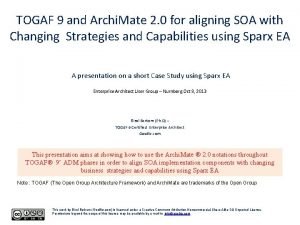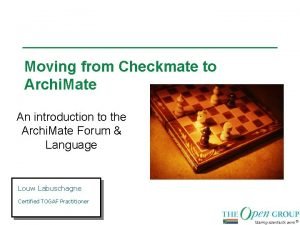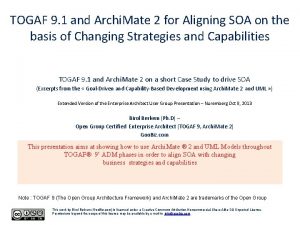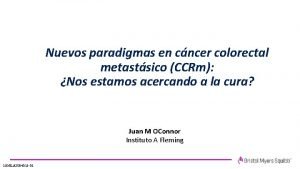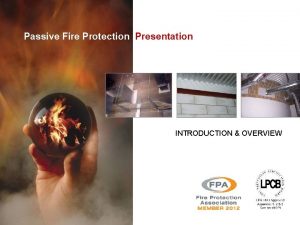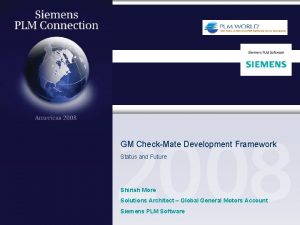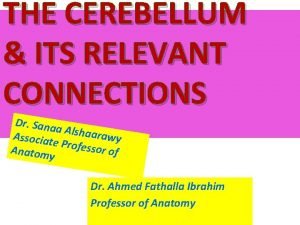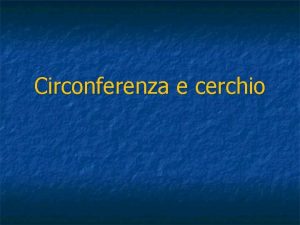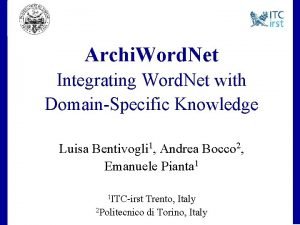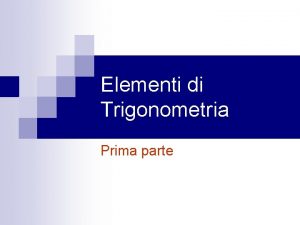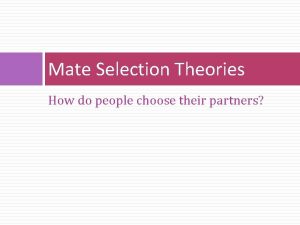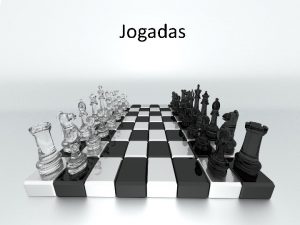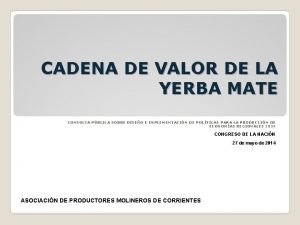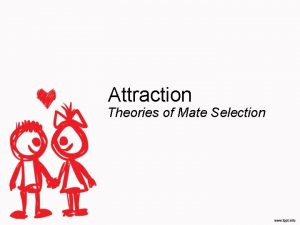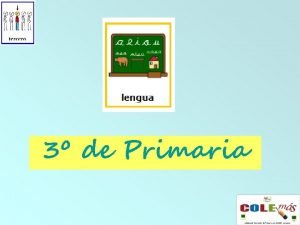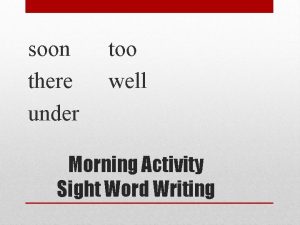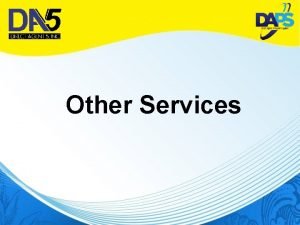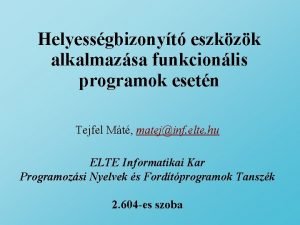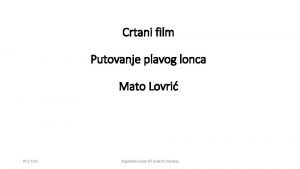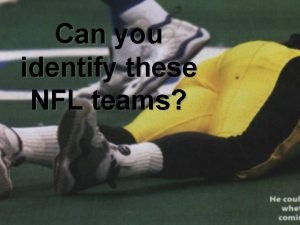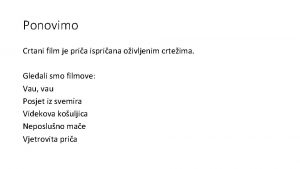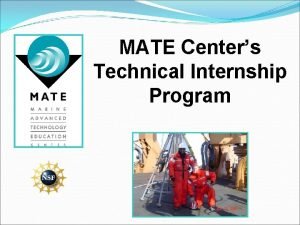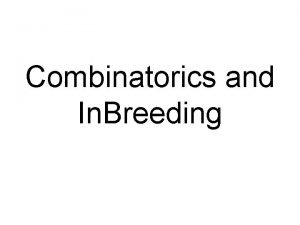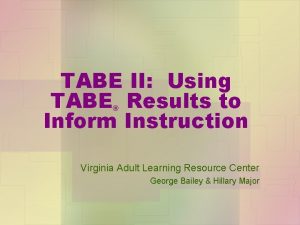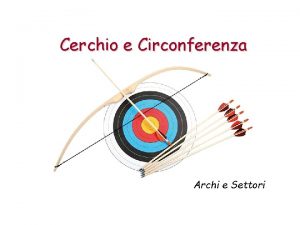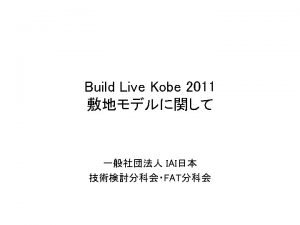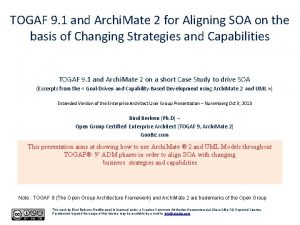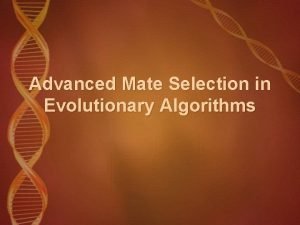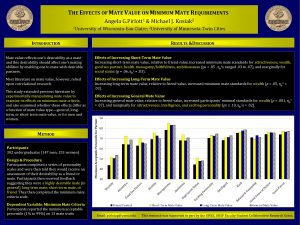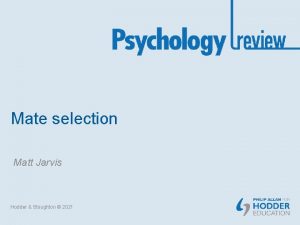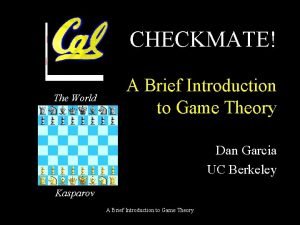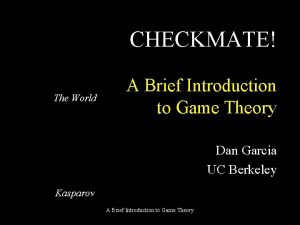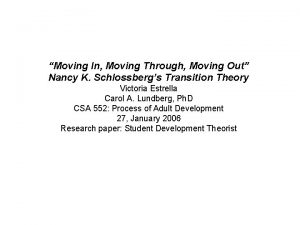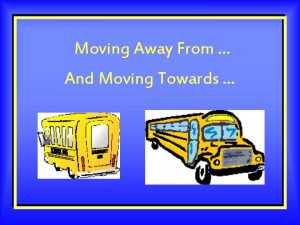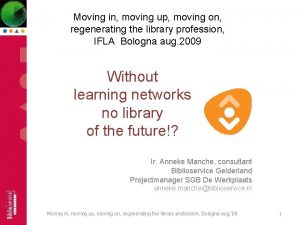Moving from Checkmate to Archi Mate An introduction






![Introduction to [Ahr-ki-meyt] q q Archi. Mate provides instruments to support enterprise architects in Introduction to [Ahr-ki-meyt] q q Archi. Mate provides instruments to support enterprise architects in](https://slidetodoc.com/presentation_image_h/0b0208a41c800e6cccea3977a8d9f47a/image-7.jpg)





































- Slides: 44

Moving from Checkmate to Archi. Mate An introduction to the Archi. Mate Forum & Language Louw Labuschagne Certified TOGAF Practitioner

Agenda q q q Why use a formal Enterprise Architecture Language Where did Archi. Mate originate How is Archi. Mate constructed When should you use different views What do I need to know when modelling in a tool Who do I contact to join the Open Group or the Archi. Mate Forum

Agenda q q q Why use a formal Enterprise Architecture Language Where did Archi. Mate originate How is Archi. Mate constructed When should you use different views What do I need to know when modelling in a tool Who do I contact to join the Open Group or the Archi. Mate Forum

Have you ever seen the following happen? THE QUICK BROWN FOX JUMPS OVER THE LAZY DOG A B C D E F G H I J K L M N O P Q R S T U V W X Apply English Language Rules Y Y Z Z

Can you now answer the question? THE QUICK BROWN FOX JUMPS OVER THE LAZY DOG. . . Because everyone in the room were taught the english language rules. . . q Standard form for each shape q Standard spelling for using shapes q Standard pronunciations for each shape q Standard meanings of each shape q Standard rules for the use of shapes

Key requirements of an Enterprise Architecture Modelling Language q q Focused on modelling inter-domain relations Modelling the global structure within each domain, showing the main elements and their dependencies, in a way that is easy to understand for non-experts of the domain Models must be interpreted in an unambiguous way Visualise models in a different way, tailored towards specific stakeholders with specific information requirements
![Introduction to Ahrkimeyt q q Archi Mate provides instruments to support enterprise architects in Introduction to [Ahr-ki-meyt] q q Archi. Mate provides instruments to support enterprise architects in](https://slidetodoc.com/presentation_image_h/0b0208a41c800e6cccea3977a8d9f47a/image-7.jpg)
Introduction to [Ahr-ki-meyt] q q Archi. Mate provides instruments to support enterprise architects in describing, analysing and visualising the relationships among business domains in an unambiguous way Archi. Mate is an open and independent modelling language for enterprise architecture Supported by leading EA tool vendors Tailored towards specific stakeholders addressing specific information requirements

Agenda q q q Why use a formal Enterprise Architecture Language Where did Archi. Mate originate How is Archi. Mate constructed When should you use different views What do I need to know when modelling in a tool Who do I contact to join the Open Group or the Archi. Mate Forum

History q q q Archi. Mate Language Primer § 2004 Telematica Instituut § http: //www. telin. nl/index. cfm? ID=252&context=253&lan guage=nl Archi. Mate Made Practical § 2007 Archimate Foundation § http: //www. archimate. org/ Archi. Mate 1. 0 Technical Standard § 2008 Open Group Review of the Technical Standard § http: //www. opengroup. org/archimate/

Focus of the Archi. Mate Forum q Standardise Archi. Mate version 1. 0 § maintain backward compatability q Develop Archi. Mate 2. 0 draft standard § tighter integration with TOGAF § still ensuring backward compatibility

Agenda q q q Why use a formal Enterprise Architecture Language Where did Archi. Mate originate How is Archi. Mate constructed When should you use different views What do I need to know when modelling in a tool Who do I contact to join the Open Group or the Archi. Mate Forum

Services Approach q A service is defined as a unit of functionality that some entity (e. g. , a system, organisation or department) makes available to its environment, and which has some value for certain entities in the environment.

Layered Approach Business Layer The Business layer offers products and services to external customers, which are realised in the organisation by business processes performed by business actors. Application Layer The Application layer supports the business layer with application services which are realised by (software) applications. Technology Layer The Technology layer offers infrastructural services (e. g. , processing, storage and communication services) needed to run applications, realised by computer and communication hardware and system software.

Language Elements q Behavioural or dynamic aspect § Behavioural concepts are assigned to structural concepts, to show who or what displays the behaviour q Structural or static aspect § Active structural elements § the business actors, application components and devices that display actual behaviour, i. e. , the ‘subjects’ of activity § Passive structural elements § q i. e. , the objects on which behaviour is performed External view and an internal view § For the external users, only this external functionality, together with non-functional aspects such as the quality of service, costs etc. , are relevant

Archi. Mate Notation Passive Structure Behaviour Active Structure

Example

Agenda q q q Why use a formal Enterprise Architecture Language Where did Archi. Mate originate How is Archi. Mate constructed When should you use different views What do I need to know when modelling in a tool Who do I contact to join the Open Group or the Archi. Mate Forum

Archi. Mate Viewpoints Purpose: navigate, design, support design decisions, compare alternatives Purpose: decision-making Purpose: explain, convince, obtain commitment Stakeholders: software engineer, process owner Purpose: design, manage Stakeholders: enterprise architect, CIO, CEO Purpose: change management Stakeholders: operational managers Purpose: Analyse dependencies, impact -of-change

Archi. Mate Informing Viewpoints These viewpoints help to inform any stakeholder about the enterprise architecture, in order to achieve understanding, obtain commitment, and convince adversaries. Typical examples are illustrations, animations, cartoons, flyers, etc.

Informal Notation Passive Structure Behaviour Active Structure

Whiteboard Friendly q q q The Introductory viewpoint tries to avoid the impression that the architectural design is already fixed, an idea that may easily arise when using a more formal, highly structured or detailed visualisation No technology required Good workshop technique with stakeholders

Decision Support Viewpoints Decision support views assist managers in the process of decision making by offering insight into cross-domain architecture relations, typically through projections and intersections of underlying models, but also by means of analytical techniques. Typical examples are cross-reference tables, landscape maps, lists and reports.

Visio q Visio Templates available from Archi. Mate Foundation website q The model on the right is used as an example of how to abstract a view for easy communication using a tool like Visio

Example q Shapes can be substituted to assist with communication

Example q New images are used to replace the standard shapes

Example q The shapes are abstracted based on the rules defined in the Archi. Mate standard

Archi. Mate Design Viewpoints Design viewpoints support architects and designers in the design process from initial sketch to detailed design. Typically, design viewpoints consist of diagrams, like those used in e. g. UML.

Agenda q q q Why use a formal Enterprise Architecture Language Where did Archi. Mate originate How is Archi. Mate constructed When should you use different views What do I need to know when modelling in a tool Who do I contact to join the Open Group or the Archi. Mate Forum

Archi. Mate Domains

Meta Model

Archi. Mate Concepts: Business

Archi. Mate Concepts: Application

Archi. Mate Concepts: Technology

Archi. Mate Design Viewpoints q From any given element in a model, we can define viewpoints in four metaphorical directions: 1. ‘inwards’, toward the internal composition of the element; 2. ‘upwards’, towards the elements that are supported by it; 3. ‘downwards’, toward its realisation by other elements; 4. ‘sideways’, towards peer elements with which it cooperates.

Composition: Business Function VIEWPOINT NAME Business Function STAKEHOLDERS Enterprise, process, domain architects CONCERNS Identification of essential activities Identification of compentencies Reduction of complexity PURPOSE Designing ABSTRACTION LEVEL Coherence LAYERS Business ASPECTS Behaviour, (Active)

Example Composition: Business Function

Cooperation: Actor VIEWPOINT NAME Actor Cooperation STAKEHOLDERS Enterprise, process, domain architects CONCERNS Relations of actors with their environment PURPOSE Designing ABSTRACTION LEVEL Coherence LAYERS Business, (application) ASPECTS Structure, behaviour

Example Cooperation: Actor

Support: Infrastructure Usage VIEWPOINT NAME Infrastructure Usage STAKEHOLDERS Application, infrastructure architects Operational managers CONCERNS Dependencies, performance, scalability PURPOSE Designing ABSTRACTION LEVEL Coherence LAYERS Application, technology ASPECTS Active, (behaviour)

Example Support: Infrastructure Usage

Realisation: Service Realisation VIEWPOINT NAME Service Realisation STAKEHOLDERS Process, domain architects Product & operational managers CONCERNS Added value of business processes Consistency & completeness Responsibilities PURPOSE Designing, deciding ABSTRACTION LEVEL Coherence LAYERS Business, (application) ASPECTS Behaviour, (active), (passive)

Example Realisation: Service Realisation

Agenda q q q Why use a formal Enterprise Architecture Language Where did Archi. Mate originate How is Archi. Mate constructed When should you use different views What do I need to know when modelling in a tool Who do I contact to join the Open Group or the Archi. Mate Forum

Open Group or Archi. Mate Forum Membership Enquiries Sarina Viljoen Certified TOGAF Practitioner e-mail s. viljoen@opengroup. org Tel: +27 11 805 3734 Fax: +27 86 532 0704 Mobile: +27 82 825 3496 Skype: sarina. viljoen www. opengroup. org
 Togaf9
Togaf9 Archi mate
Archi mate Archi mate
Archi mate Playing chess with devil
Playing chess with devil Okapi checkmate
Okapi checkmate Project checkmate
Project checkmate Checkmate 8hw
Checkmate 8hw Checkmate fire doors
Checkmate fire doors Nivolumabe
Nivolumabe Checkmate nx
Checkmate nx Emboliform
Emboliform Cerebellum consists of
Cerebellum consists of Circonferenza formule inverse
Circonferenza formule inverse Archi word
Archi word Tabelle seno e coseno
Tabelle seno e coseno Colonne tronco encefalico
Colonne tronco encefalico Why did a stale- mate develop on the western front?
Why did a stale- mate develop on the western front? Why did a stale- mate develop on the western front?
Why did a stale- mate develop on the western front? Mining mate duties and responsibilities
Mining mate duties and responsibilities Ideal mate theory
Ideal mate theory Intern mate
Intern mate Maslow's hierarchy of needs
Maslow's hierarchy of needs Roque xeque mate
Roque xeque mate Baltazar putovanje plavog lonca
Baltazar putovanje plavog lonca Cadena de valor de la yerba mate
Cadena de valor de la yerba mate Cadena de valor de la yerba mate
Cadena de valor de la yerba mate Ideal mate theory
Ideal mate theory Máté 18 21-35
Máté 18 21-35 Adjetivos calificativos del sastrecillo valiente
Adjetivos calificativos del sastrecillo valiente Heart mate
Heart mate Youtube mate
Youtube mate Pera247
Pera247 Dirty router live
Dirty router live Peon de paso
Peon de paso Tejfel máté
Tejfel máté Putovanje plavog lonca animirani film mate lovrić
Putovanje plavog lonca animirani film mate lovrić Six shooters nfl
Six shooters nfl Harbingers of sunbreak
Harbingers of sunbreak Kramodo
Kramodo Ružno pače mate lovrić
Ružno pače mate lovrić Internship mate
Internship mate Dog mate
Dog mate Tabe mate
Tabe mate Mate a sel
Mate a sel Csanád máté
Csanád máté
